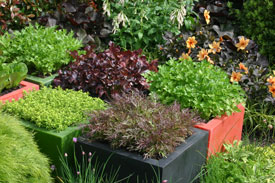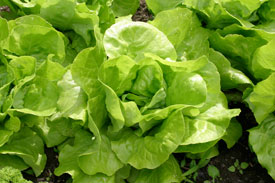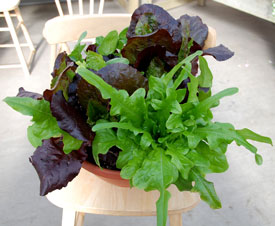Grow greens to go
Sarah O'Neil explores the delights of growing a constant supply of fresh healthy greens to feed the family - 365 days of the year.
Eat Your Greens! This has been the cry from mothers for generations as they lovingly prepare nutritious meals for their families only to find their offspring are completely unenthusiastic about the leafy green portion on their plates. It doesn't really matter how it has been prepared - in a salad, stir fry or side dish, kids seem to have a natural aversion to all things green served to them. But there is such a wonderful array of leafy green vegetables and even more amazing ways to prepare them, that to avoid a whole food group based solely on colour seems a little misguided, especially as they are actually really good for you. They are loaded with vitamins and minerals, dietary fibre and all sorts of good things for growing bodies and anybody for that matter.
The very best way to get the most flavour and nutrients out of your leafy greens is to eat them as fresh as possible, and the best way to ensure they are as fresh as possible is to grow them yourself. The good news is growing your own leafy greens isn’t expensive, doesn’t take up much space and is actually really easy - so simple a child could do it. Getting a child to help out can make things easier at the dinner table as a child who grows something is more likely to eat it willingly.
In the cooler months we desire greens that benefit from being cooked like silverbeet or the more glamorous rainbow beets, iron rich spinach, Asian greens, and the popular super food of the season – kale. For winter use, these crops are planted in autumn, but they also grow well in spring too. You can harvest the leaves as you need them and preparing these gourmet greens has come a long way from the good old days when cabbage was boiled within an inch of its life. Today’s greens are cooked quickly to retain as many nutrients as possible, and have a vibrant bright green appearance that looks and tastes much better than the soggy grey of old.
Early spring is a great time to grow microgreens on your sunniest window sill, so you can be eating something fresh and crunchy while it’s still wet and wintry outdoors. There are specific microgreen seeds available or you could grow a selection of your favourite veggies. Sprinkle the seeds quite thickly and once the seedlings are a few centimetres tall with their first set of true leaves, cut them off with a pair of scissors and enjoy the nutrient rich salad crunch that is ready for harvest in less than two weeks.
As the days get longer, we start to look forward to BBQs and alfresco dinning, and an essential part of this experience is the salad. Whether it is a traditional iceberg lettuce (back in vogue!) or a mesculun mix with a balsamic dressing, a salad is a summer staple. There is nothing more satisfying than popping out into your garden and harvesting a few leaves that get sprinkled in dressing moments later.
The key to a constant supply of salad greens throughout the warmer months is to plant little and often. While a crisp fresh salad is what we feel like most on a hot summer’s day, the irony is that most salad greens actually prefer cooler weather. When temperatures rise they can quickly bolt to seed and taste bitter. The best way around this is to plant about half a dozen seedlings every couple of weeks throughout the summer months, whether you are sowing your own seed or buying seedlings from your garden centre. Harvest any plants as soon as there is the slightest hint of bitterness coming through in the leaves. That way you can always guarantee that you will have the sweetest, tender leaves every time. Planting often can also allow you to try a variety of different salad ingredients throughout the season.
The widest choice of different salad greens comes from growing your own. Basically, there two kinds of lettuce – the loose leaf variety, where you can take the outer leaves as the plant grows and is often referred to as ‘cut and come again’ as you can harvest repeatedly from the same plant and it will keep on growing. Then there is the kind of lettuces that forms a solid heart and it is best to harvest the whole plant. These can take up to eight weeks to mature, whereas the loose leaf varieties can be harvested within three weeks as tender baby greens.
Whether you prefer the spicy flavours of rocket and mustard greens, or the more sweet and nutty flavours of Buttercrunch lettuce, they can all be grown simply and easily in your garden or in a container by your backdoor. Garden centres offer a fantastic array of salad plants in punnets, including mixed packs of different shapes and colours so you are able to have an amazing mixed leaf salad that will tempt the pickiest of eaters.
Seeds also offer a great deal of choice and you can purchase a specific lettuce or a mixed packet which gives you an assortment of salad leaves throughout the whole season. However, be careful not to sow the seeds all at once as there are generally around 1000 seeds in a packet. So unless you want a slimy mess – less is more!
An easy option for those unfamiliar with growing from seed, Yates Fusion range of seeds ensures a great crop of mixed greens. Ideal for planting containers, the seeds are combined in special clay pellets. Each pellet contains an interesting mix of lettuce varieties that will all germinate at the same time. The packet advises how many pellets you need for the size of your container.
Growing your greens in your garden is the freshest possible way to make sure that often maligned portion on the plate is elevated to the star of meal, and the cry ‘Eat your greens’ will be an invitation willingly accepted by everyone at the table. All year round.
Lettuce Tips:
- The faster your lettuces grow, the better they’ll taste. Don’t let them run out of water or nutrients.
- If your garden soil is not well drained plant lettuces in container mix.
- In hot summer weather some afternoon shade is beneficial.
- Lettuces need lots of nitrogen but other nutrients too. For those growing in pots, supplement slow release fertiliser with liquid fertiliser or worm tea from your worm farm.
- For the best nutrition and flavor, pick leaves fresh for each meal rather than storing them in the fridge.
20-Sep-2013

Lettuces in tubs


Yates Fusion Mix


